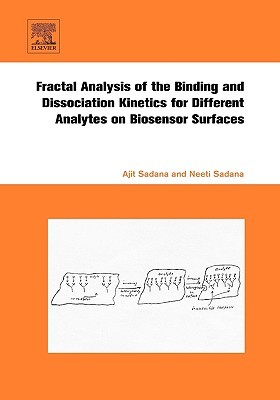
- We will send in 10–14 business days.
- Author: Ajit Sadana
- Publisher: Elsevier Science
- ISBN-10: 044453010X
- ISBN-13: 9780444530103
- Format: 17.3 x 22.7 x 2.2 cm, hardcover
- Language: English
- SAVE -10% with code: EXTRA
Fractal Analysis of the Binding and Dissociation Kinetics for Different Analytes on Biosensor Surfaces (e-book) (used book) | bookbook.eu
Reviews
Description
Biosensors are finding increasing applications in different areas. Over the last few years the areas where biosensors may be used effectively has increased dramatically. This book like the previous four books on analyte-receptor binding and dissociation kinetics by this author addresses the often neglected area. The kinetics of binding and dissociation in solution to appropriate receptors immobilized on biosensor surfaces occurs under diffusional limitations on structured surfaces. The receptors immobilized on the biosensor surface contribute to the degree of heterogeneity on the sensor chip surface.
The fractal analysis examples presented throughout the book provide a convenient means to make quantitative the degree of heterogeneity present on the sensor surface, and relates it to the binding and dissociation rate coefficients. The fractal dimension is a quantitative measure of the degree of heterogeneity present on the biosensor surface. The book emphasizes medially-oriented examples. The detection of disease-related analytes is also emphasized. The intent being that if intractable and insidious diseases are detected earlier, they will be controlled better, eventually leading to a better prognosis. Chapter 3 is a new chapter that emphasizes enhancing the relevant biosensor performance parameters such as sensitivity, stability, selectivity, response time, etc.
As usual, as done in previous books by this author, the last chapter provides an update of the economics involved in biosensors, and the difficulties encounters in starting-up a biosensor company.
EXTRA 10 % discount with code: EXTRA
The promotion ends in 20d.14:39:50
The discount code is valid when purchasing from 10 €. Discounts do not stack.
- Author: Ajit Sadana
- Publisher: Elsevier Science
- ISBN-10: 044453010X
- ISBN-13: 9780444530103
- Format: 17.3 x 22.7 x 2.2 cm, hardcover
- Language: English English
Biosensors are finding increasing applications in different areas. Over the last few years the areas where biosensors may be used effectively has increased dramatically. This book like the previous four books on analyte-receptor binding and dissociation kinetics by this author addresses the often neglected area. The kinetics of binding and dissociation in solution to appropriate receptors immobilized on biosensor surfaces occurs under diffusional limitations on structured surfaces. The receptors immobilized on the biosensor surface contribute to the degree of heterogeneity on the sensor chip surface.
The fractal analysis examples presented throughout the book provide a convenient means to make quantitative the degree of heterogeneity present on the sensor surface, and relates it to the binding and dissociation rate coefficients. The fractal dimension is a quantitative measure of the degree of heterogeneity present on the biosensor surface. The book emphasizes medially-oriented examples. The detection of disease-related analytes is also emphasized. The intent being that if intractable and insidious diseases are detected earlier, they will be controlled better, eventually leading to a better prognosis. Chapter 3 is a new chapter that emphasizes enhancing the relevant biosensor performance parameters such as sensitivity, stability, selectivity, response time, etc.
As usual, as done in previous books by this author, the last chapter provides an update of the economics involved in biosensors, and the difficulties encounters in starting-up a biosensor company.


Reviews